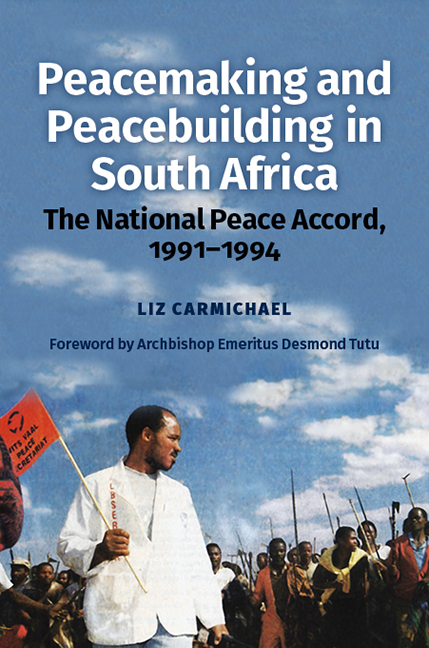Book contents
- Frontmatter
- Dedication
- Contents
- List of Illustrations
- List of Abbreviations
- Glossary
- Acknowledgements
- Note on Nomenclature
- Transition Timeline
- Foreword
- Introduction
- Part One Peacemaking, Peacebuilding, and the South African Conflict
- Part Two Peacemaking
- Part Three Peacebuilding
- Conclusion: Impact and Unfinished Business
- Bibliography
- Index
1 - Peacemaking and Peacebuilding: Situating South Africa
Published online by Cambridge University Press: 08 October 2022
- Frontmatter
- Dedication
- Contents
- List of Illustrations
- List of Abbreviations
- Glossary
- Acknowledgements
- Note on Nomenclature
- Transition Timeline
- Foreword
- Introduction
- Part One Peacemaking, Peacebuilding, and the South African Conflict
- Part Two Peacemaking
- Part Three Peacebuilding
- Conclusion: Impact and Unfinished Business
- Bibliography
- Index
Summary
In February 1990, more than forty years after the imposition of apartheid by the National Party government in 1948, the new State President F. W. de Klerk unbanned the ANC and other liberation movements, and released Nelson Mandela.
Two results were expected: the commencement of multiparty talks to formulate a new constitution and hold the first-ever fully democratic election; and the ending of the low-intensity civil war in Natal/KwaZulu, which for five years had pitted ANC supporters against the conservative Zulu Inkatha movement. However, neither result materialized. Only bilateral talks were held, mainly between the government and ANC focusing on the release of political prisoners and return of exiles. For a year, ANC ‘hawks’ prevented a meeting between Mandela and Inkatha leader Chief Buthelezi, while Inkatha became the ‘Inkatha Freedom Party’ (IFP) and the ANC–IFP conflict spread to the townships around Johannesburg.
A crisis point was reached in April 1991 when the ANC, blaming the government for both police and Inkatha violence, threatened to call off all talks. At that point, twelve church and business leaders formed a facilitating group and succeeded in bringing the government, ANC, IFP and a wide spectrum of politicians together for the first time to negotiate peace agreements. These agreements became the National Peace Accord (NPA), the first ‘negotiated understanding among the representative leaders of the entire population’.1 With the Accord in place the constitutional talks could commence, in parallel with grassroots peacemaking and peacebuilding throughout the land through the peace structures set up under the Accord.
But what is ‘peace’? At first there was hardly any popular knowledge of the provisions of the Accord, and grassroots definitions can be startlingly context- specific. A definition spat out on the street at the height of the violence in Alexandra township, Johannesburg, in April 1992 ran simply: ‘Peace? Peace is when those people go away’.
Just five months later the Alexandra ICC, the local peace committee formed on 1 April under the NPA, held a weekend retreat. ANC and IFP from the opposing township and hostels, police, army, Women for Peace, churches and business together envisioned a peaceful future and the process required to get there:
- Type
- Chapter
- Information
- Peacemaking and Peacebuilding in South AfricaThe National Peace Accord, 1991-1994, pp. 7 - 16Publisher: Boydell & BrewerPrint publication year: 2022



